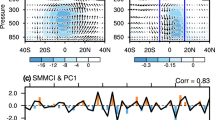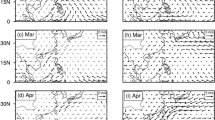Abstract
Response of the North Pacific subtropical countercurrent (STCC) and its variability to global warming is examined in a state-of-the-art coupled model that is forced by increasing greenhouse gas concentrations. Compared with the present climate, the upper ocean is more stratified, and the mixed layer depth (MLD) shoals in warmer climate. The maximum change of winter MLD appears in the Kuroshio–Oyashio extension (KOE) region, where the mean MLD is the deepest in the North Pacific. This weakens the MLD front and reduces lateral induction. As a result of the reduced subduction rate and a decrease in sea surface density in KOE, mode waters form on lighter isopycnals with reduced thickness. Advected southward, the weakened mode waters decelerate the STCC. On decadal timescales, the dominant mode of sea surface height in the central subtropical gyre represents STCC variability. This STCC mode decays as CO2 concentrations double in the twenty-first century, owing both to weakened mode waters in the mean state and to reduced variability in mode waters. The reduced mode-water variability can be traced upstream to reduced variations in winter MLD front and subduction in the KOE region where mode water forms.











Similar content being viewed by others
References
Aoki Y, Suga T, Hanawa K (2002) Subsurface subtropical fronts of the North Pacific as inherent boundaries in the ventilated thermocline. J Phys Oceanogr 32:2299–2311
Delworth TL et al (2006) GFDL’s CM2 global coupled climate models. Part I: formulation and simulation characteristics. J Climate 19(5). doi:10.1175/JCLI3629.1
GFDL Global Atmospheric Model Development Team (2004) The new GFDL global atmosphere and land model AM2-LM2: evaluation with prescribed SST simulations. J Climate 17:4641–4673
Hanawa K, Talley LD (2001) Mode waters. In: Siedler G, Church J, Gould J (eds) Ocean circulation and climate. International Geophysics. Elsevier, New York, pp 373–386
Kobashi F, Mitsudera H, Xie S-P (2006) Three subtropical fronts in the North Pacific: observational evidence for mode water-induced subsurface frontogensis. J Geophys Res Oceans 111:C09033. doi:10.1029/2006JC003479
Kobashi F, Xie S-P, Iwasaka N, Sakamoto T (2008) Deep atmospheric response to the North Pacific oceanic subtropical front in spring. J Climate 21:5960–5975
Kubokawa A (1997) A two-level model of subtropical gyre and subtropical countercurrent. J Oceanogr 53:231–244
Kubokawa A (1999) Ventilated thermocline strongly affected by a deep mixed layer: a theory for subtropical countercurrent. J Phys Oceanogr 29:1314–1333
Kubokawa A, Inui T (1999) Subtropical countercurrent in an idealized ocean GCM. J Phys Oceanogr 29:1303–1313
Lee H-C (2009) Impact of atmospheric CO2 doubling on the North Pacific subtropical mode water. Geophys Res Lett 36:L06602. doi:10.1029/2008GL037075
Lin S-J (2004) A “vertically Lagrangian” finite-volume dynamical core for global models. Mon Weather Rev 132:2293–2307
Luo Y, Liu Q, Rothstein LM (2009) Simulated response of North Pacific mode waters to global warming. Geophys Res Lett 36:L23609. doi:10.1029/2009GL040906
Nakamura H (1996) A pycnostad on the bottom of the ventilated portion in the central subtropical North Pacific: its distribution and formation. J Oceanogr 52:171–188
Nonaka M, Xie S-P, Sasaki H (2011) Interannual variations in low potential vorticity water and the subtropical countercurrent in an eddy-resolving OGCM. J Oceanogr (in press)
Qiu B, Hwang X (1995) Ventilation of the North Atlantic and North Pacific: subduction versus obduction. J Phys Oceanogr 25:2374–2390
Qu T, Chen J (2009) A North Pacific decadal variability in subduction rate. Geophys Res Lett 36:L22602. doi:10.1029/2009GL040914
Sakamoto T, Hasumi H, Ishii M, Emori S, Suzuki T, Nishimura T, Sumi A (2005) Responses of the Kuroshio and the Kuroshio extension to global warming in a high-resolution climate model. Geophys Res Lett 32:L14617. doi:10.1029/2005GL023384
Sasaki H, Xie S-P, Taguchi B, Nonaka M, Hosoda S, Masumoto Y (2011) Interannual variations of the Hawaiian Lee countercurrent induced by low potential vorticity water ventilation in the subsurface. J Oceanogr (submitted)
Sato Y, Yukimoto S, Tsujino H, Ishizaki H, Noda A (2006) Response of North Pacific ocean circulation in a Kuroshio-resolving ocean model to an Arctic oscillation (AO)-like change in Northern Hemisphere atmospheric circulation due to greenhouse-gas forcing. J Meteorol Soc Jpn 84:295309
Stouffer RJ et al (2006) GFDL’s CM2 global coupled climate models. Part IV: idealized climate response. J Climate 19:723–740
Suga T, Hanawa K, Toba Y (1989) Subtropical mode water in the 137°E section. J Phys Oceanogr 19:1605–1618
Suga T, Takei Y, Hanawa K (1997) Thermostad distribution in the North Pacific subtropical gyre: the central mode water and the subtropical mode water. J Phys Oceanogr 27:140–152
Suga T, Motoki K, Aoki Y, McDonald AM (2004) The North Pacific climatology of winter mixed layer and mode waters. J Climate 34:3–22
Sutton RT, Dong B, Gregory JM (2007) Land/sea warming ratio in response to climate change: IPCC AR4 model results and comparison with observations. Geophys Res Lett 34:L02701. doi:10.2029/2006GL028164
Takeuchi K (1984) Numerical study of the subtropical front and the subtropical countercurrent. J Oceanogr Soc Jpn 40:371–381
Thompson L, Cheng W (2008) Water masses in the Pacific in CCSM3. J Climate 21:4514–4528
Uda M, Hasunuma K (1969) The eastward subtropical countercurrent in the western North Pacific Ocean. J Oceanogr Soc Jpn 25:201–210
White WB, Hasunuma K, Solomon H (1978) Large-scale seasonal, secular variability of the subtropical front in the western North Pacific from 1954 to 1974. J Geophys Res 83:4531–4544
Williams RG (1991) The role of the mixed layer in setting the potential vorticity of the main thermocline. J Phys Oceanogr 21:1803–1814
Xie S-P, Kunitani T, Kubokawa A, Nonaka M, Hosoda S (2000) Interdecadal thermocline variability in the North Pacific for 1958–1997: a GCM simulation. J Phys Oceanogr 30:2798–2813
Xie S-P, Deser C, Vecchi GA, Ma J, Teng H, Wittenberg AT (2010) Global warming pattern formation: Sea surface temperature and rainfall. J Climate 23:966–986
Xie S-P, Xu L, Liu Q, Kobashi F (2011) Dynamical role of mode water ventilation in decadal variability in the central subtropical gyre of the North Pacific. J Climate 24:1212–1225
Yamanaka G, Ishizaki H, Hirabara M, Ishikawa I (2008) Decadal variability of the subtropical front of the western North Pacific in an eddy-resolving ocean general circulation model. J Geophys Res 113:C12027. doi:10.1029/2008JC005002
Yoshida K, Kidokoro T (1967) A subtropical countercurrent in the North Pacific—an eastward flow near the subtropical convergence. J Oceanogr Soc Jpn 23:88–91
Acknowledgments
We thank the anonymous reviewers for constructive and helpful comments. This work is supported by the Qianren project, Changjiang Scholar Program, Natural Science Foundation of China (40830106, 40921004), National Key Program for Developing Basic Science of China 2007CB411803 and 2010CB428904, the US National Science Foundation, and the Japan Agency for Marine Earth Science and Technology.
Author information
Authors and Affiliations
Corresponding author
Appendix: Comparison with observations
Appendix: Comparison with observations
Our recent study (Sect. 3a of Xie et al. 2011) compared the control run of GFDL CM2.1, the same model used here, with observations; here we just provide a brief comparison of key variables from 20C3M against previous observational studies.
Using hydrographic data, Suga et al. (2004) showed that the winter MLD exhibits two distinct maximum, one to the south of the KE and one to the north, which are the formation regions for the STMW and the CMW, respectively. Compared to observations, Fig. 1a exhibits a broad, zonally elongated region of deep mixed layer, resulting in too extensive formation of mode waters (Suga et al. 2004; Thompson and Cheng 2008). The zonal elongated region of deep MLD may have caused spatial biases in the maximum subduction rate in Fig. 1a displaced too east compared to observations (e.g., Qiu and Hwang 1995; Qu and Chen 2009). According to Suga et al. (2004), small cross-isopycnal flow in the mixed layer plays a key role in the CMW formation, whereas it is the lateral induction in this model.
In observations, the STMW (CMW) is found in a density range of 25.3–25.7 σ θ (26.1–26.5 σ θ ) [Suga et al. 1989, 1997, 2004; Nakamura 1996; Hanawa and Talley 2001]. For 20C3M, the STMW (CMW) is clustered in 25.4–25.7 σ θ (26.2–26.6 σ θ ). The model mode waters are slightly denser by 0.1 σ θ , but the density range of the two mode waters is broadly consistent with observations. However, the typical minimum PV of mode waters is ~1.5 × 10−10 m−1 s−1 in the observed climatology, whereas it is ~0.5 × 10−10 m−1 s−1 in the model (Fig. 7b). Moreover, the low-PV tongue on the isopycnal is much more diffused in observations than in the model, with a broader spatial structure and larger PV values (Fig. 5b of Xie et al. 2011).
In the observed meridional transect (Fig. 3b of Xie et al. 2011), the maximum zonal velocity of STCC is ~3 m s−1 at 26.5°N, anchored by PV minima on 25.5–26.5 σ θ to the north. The observed zonal velocity of STCC is much weaker than in the model, and these PV minima north of STCC are not as pronounced as in the model. The eastern STCC that we mainly focused on in this study seems to be too strong in 20C3M compared to observations, a bias likely due to too strong mode waters.
Rights and permissions
About this article
Cite this article
Xu, L., Xie, SP., Liu, Q. et al. Response of the North Pacific subtropical countercurrent and its variability to global warming. J Oceanogr 68, 127–137 (2012). https://doi.org/10.1007/s10872-011-0031-6
Received:
Revised:
Accepted:
Published:
Issue Date:
DOI: https://doi.org/10.1007/s10872-011-0031-6




